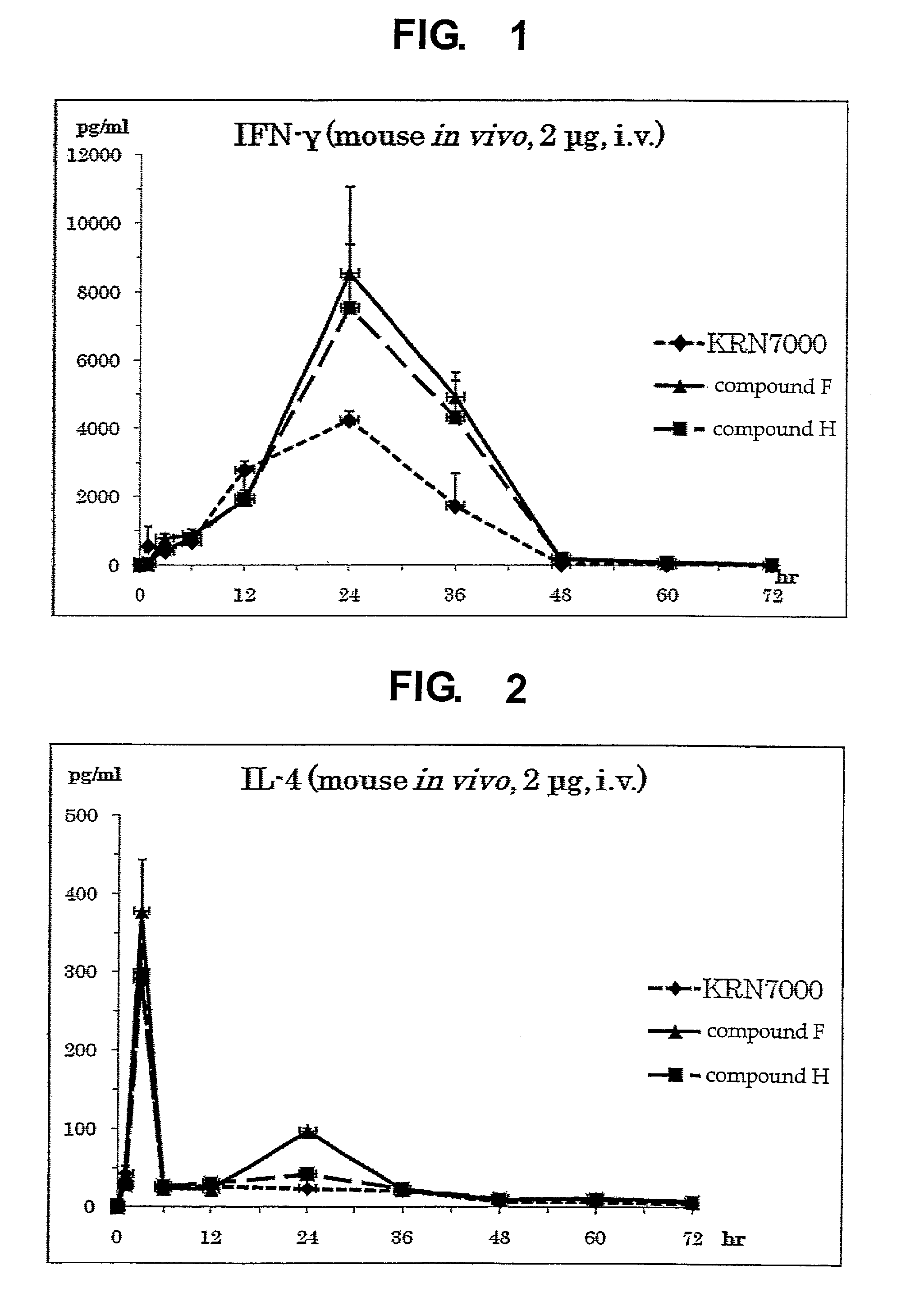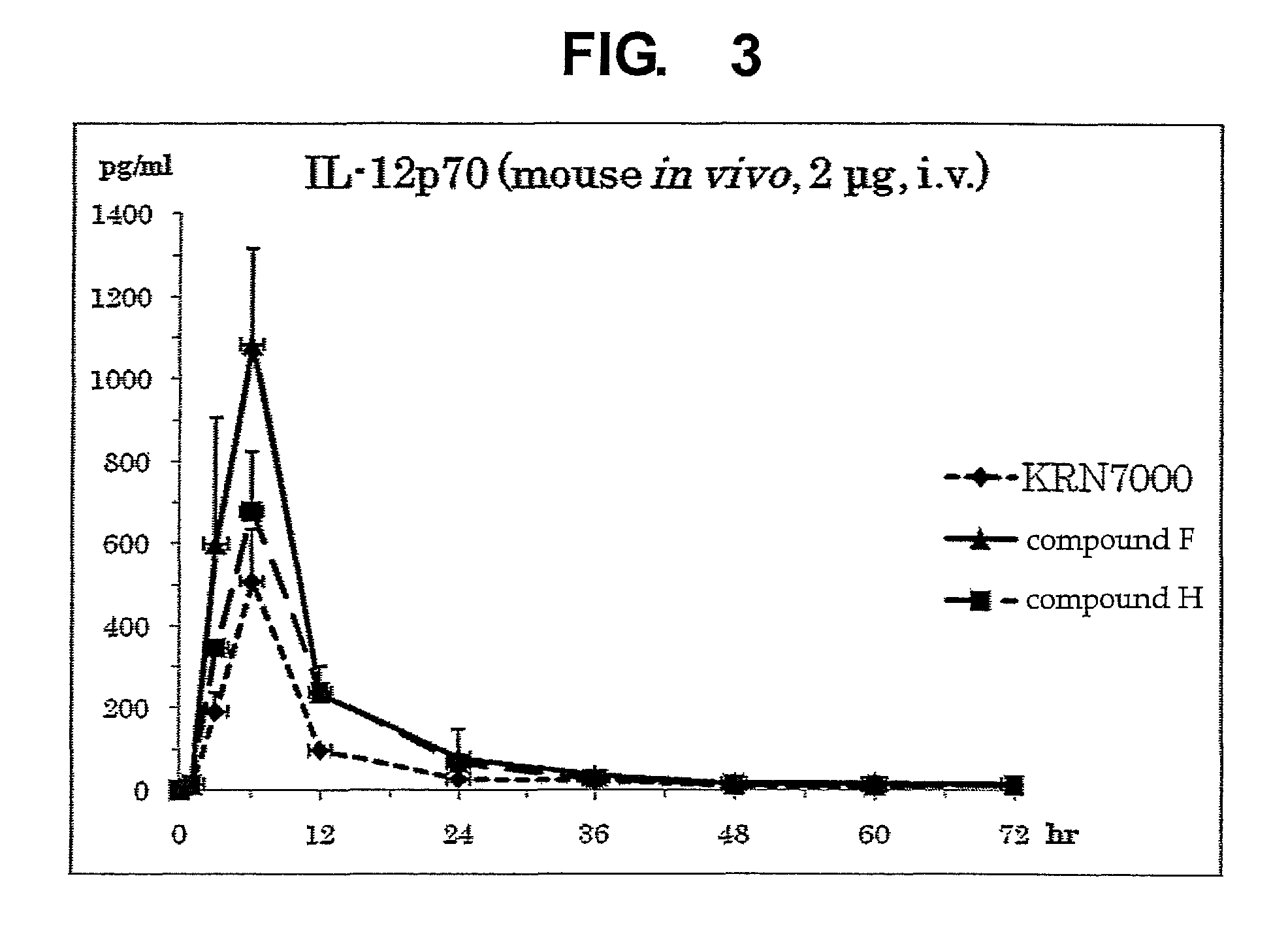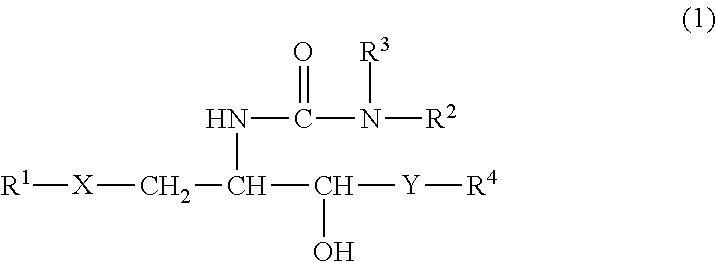Synthetic glycolipid and use thereof
a glycolipid and synthesizing technology, applied in the field of new glycolipids, can solve problems such as placing physical burden, and achieve the effects of easy synthesizing, sufficient efficacy, and intense activation of nkt cells
- Summary
- Abstract
- Description
- Claims
- Application Information
AI Technical Summary
Benefits of technology
Problems solved by technology
Method used
Image
Examples
example 1
Synthesis of Compound F
[0141]The synthesis processes are as described in the following scheme.
[0142]
Synthesis of Compound B
[0143]A suspension of commercially available compound A (310 mg, 0.810 mmol) in anhydrous benzene (5 mL) was heated to 60° C. to allow dissolution. To the obtained solution was added oxalyl chloride (1.0 mL, 12 mmol) at 60° C. The reaction mixture was stirred at 60° C. for 2 hr and concentrated under reduced pressure to give an acid chloride.
[0144]The obtained acid chloride was dissolved in a mixed solvent of tetrahydrofuran (5 ml) and N,N-dimethylformamide (2 mL), and cooled to 0° C. A solution of sodium azide (107 mg, 1.65 mmol) in water (1 mL) was slowly added at 0° C., and the mixture was stirred at 0° C. for 2 hr. The reaction mixture was diluted with benzene and washed successively with water and saturated brine, and the organic layer was dried over anhydrous sodium sulfate. After filtration, the filtrate was stirred at 70° C. for 2 hr, concentrated under...
example 2
Synthesis of Compound G
[0165]
[0166]Compound G was synthesized in the same manner as in Example 1.
[0167][α]D26=+55.7 (c=0.30, pyridine).
[0168]IR (KBr): νmax=3320 (br s, OH, NH), 1630 (br s, C═O), 1570 (br s), 1070 (br s, C—O), 1030 (br s, C—O) cm−1.
[0169]1H-NMR (500 MHz, pyridine-d5): δ=6.81 (1H, t, J=5.5 Hz), 6.79 (1H, d, J=9.5 Hz), 6.66-5.70 (6H, m), 5.54 (1H, d, J=4.0 Hz), 5.10-5.05 (1H, m), 4.61 (1H, dd, J=9.5, 3.5 Hz), 4.59 (1H, dd, J=11, 4.5 Hz), 4.48 (1H, d, J=3.0 Hz), 4.47-4.42 (2H, m), 4.41-4.33 (2H, m), 4.37 (1H, dd, J=11, 6.0 Hz), 4.28-4.23 (2H, m), 3.48 (1H, ddt, J=13, 7.5, 5.5 Hz), 3.40 (1H, ddt, J=13, 7.5, 5.5 Hz), 2.28-2.21 (1H, m), 1.92-1.78 (2H, m), 1.66-1.56 (1H, m), 1.55 (2H, quint., J=7.5 Hz), 1.43-1.15 (48H, m), 0.84 (6H, t, J=7.0 Hz) ppm.
[0170]13C-NMR (126 MHz, pyridine-d5): δ=159.5, 101.6, 77.4, 73.0, 72.8, 71.6, 70.9, 70.2, 69.7, 62.7, 52.0, 40.6, 34.7, 32.1, 31.0, 30.4, 30.1, 30.01, 29.98, 29.92, 29.91, 29.7, 29.6, 27.4, 26.5, 22.9, 14.3 ppm.
[0171]HR-ESIMS: C...
example 3
Synthesis of Compound H
[0172]
[0173]Compound H was synthesized in the same manner as in Example 1.
[0174][α]D25=+50.2 (c=0.29, pyridine).
[0175]IR (KBr): νmax=3340 (br s, OH, NH), 1640 (br s, C═O), 1570 (br s), 1070 (br s, C—O), 1035 (br s, C—O) cm−1.
[0176]1H-NMR (500 MHz, pyridine-d5): δ=7.04 (1H, br s), 6.77 (1H, t, J=5.5 Hz), 6.68 (1H, d, J=9.0 Hz), 6.63 (1H, br s), 6.29 (2H, br s), 6.01 (1H, d, J=5.5 Hz), 5.51 (1H, d, J=4.0 Hz), 5.09 (1H, dq, J=8.5, 4.0 Hz), 4.60 (1H, dd, J=11, 5.5 Hz), 4.57 (1H, dd, J=10, 4.0 Hz), 4.42-4.36 (2H, m), 4.33-4.21 (4H, m), 3.95 (1H, dd, J=10, 5.5 Hz), 3.90 (1H, dd, J=10, 7.0 Hz), 3.48 (1H, ddt, J=13, 7.0, 5.5 Hz), 3.40 (1H, ddt, J=13, 7.0, 5.5 Hz), 3.32 (3H, s), 2.29-2.21 (1H, m), 1.92-1.78 (2H, m), 1.67-1.58 (1H, m), 1.56 (2H, quint., J=7.0 Hz), 1.44-1.17 (64H, m), 0.84 (6H, t, J=7.0 Hz) ppm.
[0177]13C-NMR (126 MHz, pyridine-d5): δ=159.3, 101.5, 77.3, 72.9, 72.8, 71.3, 70.7, 70.6, 70.0, 69.6, 58.8, 51.8, 40.6, 34.8, 32.1, 31.0, 30.3, 30.1, 30.01, 30.00...
PUM
| Property | Measurement | Unit |
|---|---|---|
| carbon number | aaaaa | aaaaa |
| temperature | aaaaa | aaaaa |
| temperature | aaaaa | aaaaa |
Abstract
Description
Claims
Application Information
 Login to View More
Login to View More - R&D
- Intellectual Property
- Life Sciences
- Materials
- Tech Scout
- Unparalleled Data Quality
- Higher Quality Content
- 60% Fewer Hallucinations
Browse by: Latest US Patents, China's latest patents, Technical Efficacy Thesaurus, Application Domain, Technology Topic, Popular Technical Reports.
© 2025 PatSnap. All rights reserved.Legal|Privacy policy|Modern Slavery Act Transparency Statement|Sitemap|About US| Contact US: help@patsnap.com



